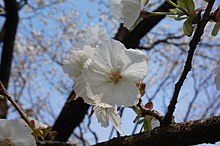Collingwood Ingram
Collingwood's uncle, Sir Edward Charles Stirling, was a noted anthropologist, physiologist and museum director, with a great interest in the natural world.
[5] In the early 1900s, Sir William Ingram employed Wilfred Stalker to collect bird skins in Australia for Collingwood to identify and catalogue at the London Natural History Museum, resulting in his first major publication.
However his main interest was in the field study of birds; he made the first record of marsh warblers breeding in Kent.
His 1916–18 journals record his war experiences and also his off-duty bird observations, with many sketches made behind the lines in northern France.
He interrogated pilots, including Charles Portal, on the height at which birds fly, resulting in a short paper after the War.
It was on this visit that he was shown a painting of a beautiful white cherry, then thought to be extinct in Japan.
This book recounts the important, almost central, role of cherries in the history and culture of Japan, and describes Ingram's contribution.
